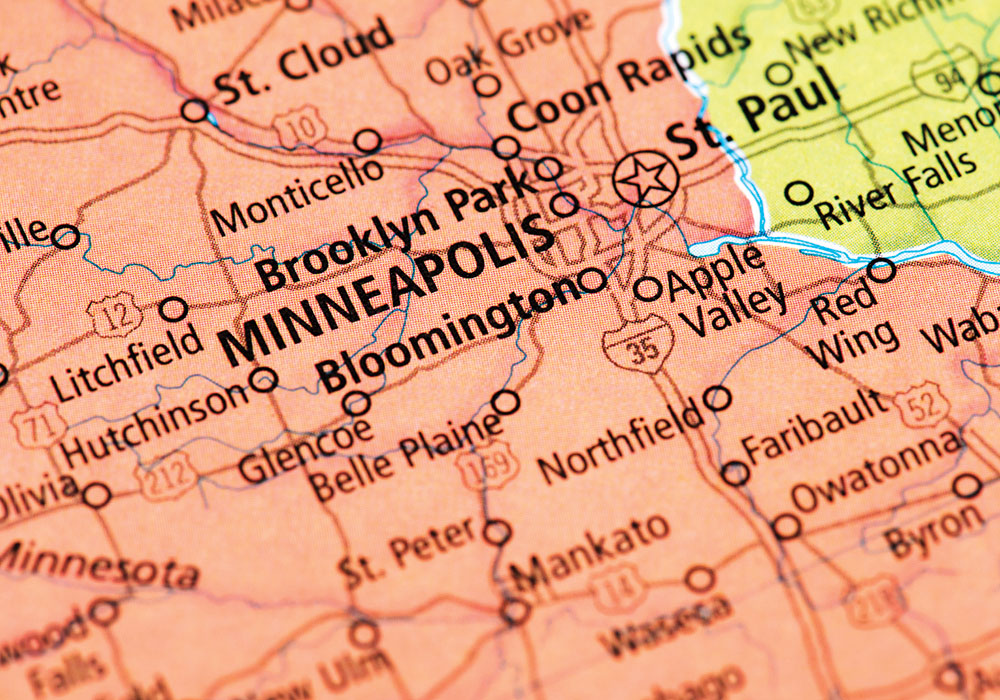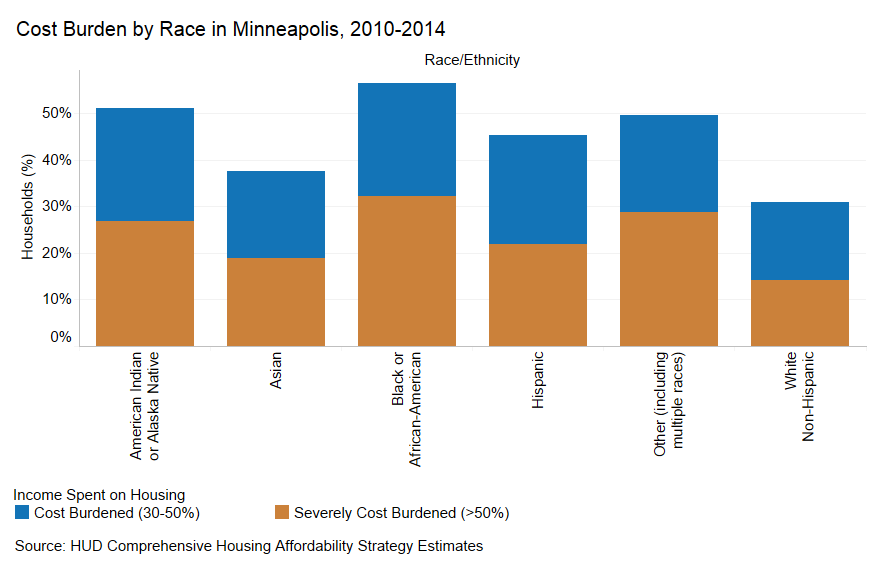Planning Home Case Study: Minneapolis, Minnesota
Addressing Racial Housing Disparities
Community Challenge

Map of Minneapolis, Minnesota
In Minneapolis, since 2000, rising home prices and rents have resulted in a growing percentage of individuals and households that are "cost-burdened" by housing. This means they are spending more than 30 percent of their income on housing expenses.
The city estimates that about 15,000 units of housing that had been affordable in 2000 are now out of reach for households at the 50 percent of area median income level.
The problem is disproportionately affecting people of color in the city. Specifically, according to the HUD Comprehensive Affordable Housing Strategy Estimates (see table, Cost Burden by Race, 2010-2014 in the 2040 plan), more than 50 percent of Black and African American households, and more than 45 percent of Hispanic and Native American households, in Minneapolis are cost-burdened by housing. For White/Non-Hispanic families that number is around 33 percent.

In the city's new comprehensive plan, described below, Minneapolis planners describe in plain English how the discriminatory aims of federal housing and transportation policies in the 1960s effectively institutionalized housing disparities for people of color in all areas of the city. The city's long-established zoning regulations exacerbated the effects of federal home lending and highway building by designating the most desirable parts of the city — in terms of transportation connectivity, access to neighborhood services, and proximity to employment — as strictly single-family residential districts.
Planning Solution
The groundbreaking Minneapolis 2040 comprehensive plan was adopted by the city council in December 2018. (The plan is still subject to approval by the Metropolitan Council of the Twin Cities.)
The plan's analysis and presentation of current housing supply, affordability, and housing needs breaks new ground for Minneapolis, and indeed for any American city, in that the city has chosen to tackle head on the effects of zoning, land use policy, and public investment on economic and racial equality.
Mayor Jacob Frey, who took office in January 2018, explains how the city turned the typical approach for preparing a housing plan on its head:
"Both the Council and I ran on a platform of pushing back on intentional segregation and creating a diversity of housing options in every neighborhood. While there was disagreement along the way, we successfully arrived at a consensus by keeping common goals front and center."
The plan does address conventional comprehensive plan elements (on the "Topics" page), but its goals go far beyond boilerplate plan content and include policies to address affordable and accessible housing, racial and health disparities, living wage jobs, climate change resilience, equitable civic participation, public health, and transportation connectivity, among others.
"I believe there should be a direct correlation between hard work and success," says Mayor Frey. "That correlation does not exist in society at large, especially if people don't have a solid foundation from which they can rise. Housing creates that foundation and stability. And if we really care about opportunity, housing should also be a right."
The overarching aim of the plan's housing goals is to increase the number of affordable units through both production of new units (including in existing homes and buildings, as well as new construction) and removal of regulatory and financial barriers. The means by which the city will meet those goals are presented in the plan in four policies, each with eight to 10 "Action Steps" to implement each of the policies.
- Policy 1: Access to Housing. Includes six Action Steps through which the city seeks to "increase the supply of housing and its diversity of location and types."
- Policy 33: Affordable Housing Production and Preservation. Includes 11 Action Steps that can result in the production of "housing units that meet the changing needs of Minneapolis residents in terms of unit sizes, housing types, levels of affordability, and locations ..."
- Policy 35: Innovative Housing Types. Includes five Action Steps requiring the city to "Pursue innovative housing types and creative housing programs to help meet existing and future housing needs." The plan points to accessory dwelling units, single room occupancy units, and shared housing as such options.
- Policy 36: Innovative Housing Strategies and Data-Driven Decisions. Includes 11 Action Steps through which the city will "[p]ursue innovative housing strategies to maximize the creation and preservation of affordable housing; use data and research to guide and evaluate housing priorities, policies, and programs." During the upcoming plan implementation phase, the city will establish affordable housing goals for every neighborhood and also adopted an inclusionary housing ordinance to ensure production of new affordable units within market-rate developments.

As part of its plan to reverse more than 60 years of inherent racial and economic discrimination in housing affordability, availability, and location, Minneapolis will revise its zoning ordinance to allow, by right, up to three dwelling units per lot in all single-family zoning districts in the city.
Current Results
Minneapolis planners in early 2019 began the process of implementing each of the Action Steps. Much of the work will require regulatory reform, including significant text and map amendments to the city's zoning districts and development standards.
When completed the zoning ordinance will contain higher allowable residential densities in single-family zones and other zones, development standards to encourage new housing types, and disbursement of affordable housing units across the city.

